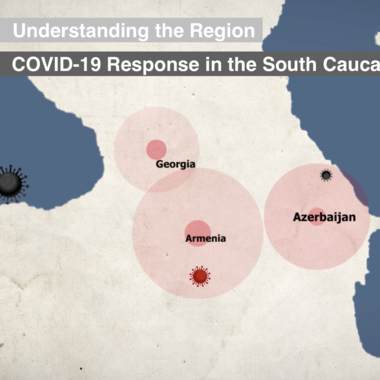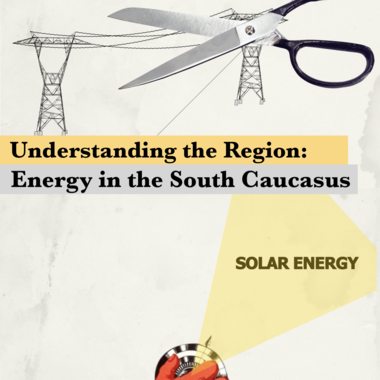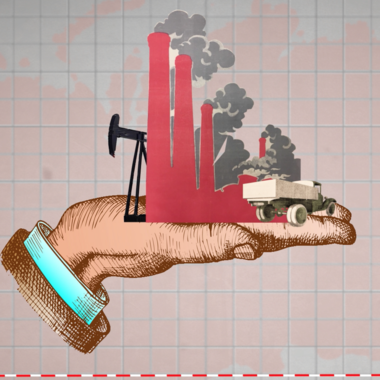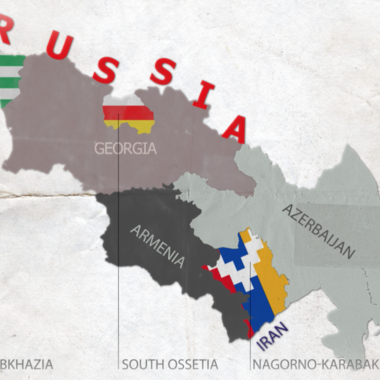Wed Sep 23 2020 · 12 min read
Understanding the Region: Agriculture in the South Caucasus

By Hovhannes Nazaretyan
Armenia, Azerbaijan and Georgia grow lots of fruits and vegetables, and animal husbandry is widespread. Agriculture remains the main occupation of more than a third of the populations of these countries. All three were part of the Soviet Union and thus, from around 1930, when the widespread collectivization of farms was forcibly undertaken, to around 1990, when privatization began, collective farms (kolkhoz) and state-owned farms (sovkhoz) dominated their agricultural sector. During the Soviet period, households that were engaged in agriculture and worked on collective or state farms would still have small garden plots and a limited number of livestock. People often secured (supplemental) income by selling the crops grown in their “private” gardens.
All three countries privatized agricultural land from 1990 on and effectively disbanded these types of collective farms such that most agricultural activity is now undertaken by small household farms. The three sovereign nations of the South Caucasus share some similarities, though their differences in agricultural resources, preferences and tastes are significant.
Armenia
Population and Labor Participation
According to the country’s Statistical Committee (ArmStat), in 2020, Armenia’s rural population made up 36% of the total (1,067,600 of 2,959,700). According to the 2011 census, 390,248 people indicated agriculture, forestry and fishing as their occupation, which amounted to almost 37% of the entire employed population (1,057,735). The vast majority (97.5%) of those involved in agriculture are self-employed or “contributing family members.” While a comparable number of men (194,081) and women (196,167) work in agriculture, the percentage of employed men working in agriculture stood at 33%, while almost 42% of employed women worked in agriculture. Naturally, most are residents of rural areas (88.7% vs. 11.3% living in urban areas). In rural areas, 70.5% are employed in agriculture, while in urban areas that figure is 7.7%.
Economy
In 2019, agriculture made up 13% of Armenia’s GDP, while fishing generated 0.5%. Animal husbandry and horticulture (plant growing) contribute almost equally to Armenia’s agricultural output: 52% vs. 48%.
Land
According to the World Bank, Armenia’s total agricultural land amounts to 16,768 sq. km, which comprises 59% of the total land area. Armenia’s total arable land is around 446,400 hectares (4,464 sq. km), comprising some 15.7% of Armenia's land area, and working out to around 0.15 ha per capita. Around one third of all arable land is used for cereal production.
Some 2,740 sq. km are equipped for irrigation, but 1,550 sq. km are actually irrigated as of 2017, per the Food and Agriculture Organization (FAO) of the United Nations. Land for organic agriculture is around 1,430 ha, of which 730 is certified organic.
Animal Husbandry
Animal husbandry in Armenia consists of poultry (chicken), sheep, cattle and pigs. Per ArmStat (2020), there are over 4.56 million poultry in Armenia, of which some 46% are kept in households, and the rest (a slight majority) in commercial organizations (poultry farms). Over 99% of almost 640,000 sheep and 580,000 cattle, and 85% of the pig population (223,000) are kept in households. Furthermore, there are almost 23,000 goats and 11,400 horses in Armenia. According to the FAO, Armenia also has 28,000 rabbits and hares and 1,758 donkeys. In 2018, Armenia had 236,242 beehives, of which 90,738 beehives had been imported that same year.
In 2018, Armenia imported 18,024 sheep and exported 11,808. Exports of cattle stood at 2,601, while imports were at 485. In the same year, Armenia imported 7,381,000 chickens.
In 2018, Armenia produced 726,800,000 hen eggs, 645,700 tons of fresh cow milk, 48,000 tons of sheep milk and 4,000 tons of goat milk. In 2014, Armenia produced 18,320 tons of whole cow milk cheese, 11,430 tons of cow milk and 1,093 tons of cow milk butter.
The country produced 68,800 tons of cattle meat (beef), 16,300 tons of pig meat (pork), 12,300 tons of chicken meat (poultry) and 10,800 tons of sheep meat (mutton).
Crops
According to FAO, in 2018, Armenia produced 646,569 tons of fruits, 560,298 tons of vegetables, 415,050 tons of roots and tubers and 334,342 tons of cereals.
The most-produced fruits were grapes (179,668 tons), apples (109,939 tons), apricots (104,035 tons), peaches and nectarines (52,247 tons).
Armenia’s top vegetable products were tomatoes (138,124 tons), watermelons (126,812 tons), cabbages and other brassicas (89,461 tons), cucumbers (50,599 tons), onions (39,279 tons), and carrots and turnips (16,681 tons). Roots and tubers consisted entirely of 415,050 tons of potatoes. Armenia also produced 54,173 tons of sugar beet.
Armenia produced 187,453 tons of wheat and 124,167 tons of barley. Cereal yield per hectare fluctuated between 2,000 and 3,200 kg in the period from 2010 to 2017.
Trade
Armenia’s largest agricultural exports are tomatoes (36,039 tons), preserved vegetables (10,114 tons), prepared fruits (9,581 tons), apricots (7,215 tons), grapes (6,536 tons), and peaches and nectarines (5,444 tons). Armenia imports significantly more than it exports. The top imports include wheat (329,372 tons), corn (67,781 tons), poultry (32,212 tons), wheat flour (29,063 tons), sunflower oil (26,086 tons), bananas (22,474 tons), prepared fruits (16,954 tons) and barley (14,839 tons).
Takeaways
Thus, Armenia imports almost 1.8 times more wheat than it produces. On the other hand, exports and imports of potatoes are negligible. Armenia exported almost 7% of its apricot harvest.
Armenia has the highest percentage of apricot production as a proportion of all fruits. Almost one sixth (16%) of all fruits produced in Armenia in 2018 were apricots. The proportion of peach production is also among the highest in the world. Around 8% of all fruits produced in Armenia were peaches, placing the country behind only Greece (20%) and Jordan (8.5%).
Georgia
Population and Labor Participation
According to the National Statistics Office of Georgia (GeoStat), as of 2020, almost 41% of Georgia’s population is rural (1,522,400 people). According to GeoStat, as of 2019, 38.1% of Georgia’s employed workforce (644,600 of 1,690,200) is employed in agriculture, forestry and fishing. According to the World Bank (2019), 44% of employed women and 40% of employed men are employed in agriculture.
Economy
In 2019, agriculture, forestry and fishing constituted 7.2% of Georgia’s GDP. Plant growing made up 43% of the agricultural output of Georgia, animal husbandry 50%, while “agricultural services” made up the rest (7%).
Land
According to the World Bank, Georgia’s total agricultural land amounts to 23,940 sq. km, which comprises 34.5% of the total land area. Georgia’s total arable land is around 344,000 hectares (3,440 sq. km), comprising some 5% of the country’s land area. Some 4,330 sq. km are equipped for irrigation. Arable land per capita is around 0.09 ha. Around 43.4% of all arable land is used for cereal production.
Land for organic agriculture is around 1,500 ha, of which around 1,000 is certified organic.
Animal Husbandry
Georgia’s animal husbandry consists of chicken, sheep, cattle and pigs. Per GeoStat (2019), there are 9.47 million chickens, 869,500 bovine animals (cattle and buffalo), 841,900 sheep and 155,500 pigs.
According to FAO (2018), Georgia also has some 51,000 goats, over 39,000 horses, 10,000 donkeys and 16,000 rabbits and hares.
In 2019, Georgia had 257,300 beehives. According to FAO, almost 13,000 beehives were imported in 2018.
In 2019, Georgia produced 661,200,000 hen eggs, 552,000 tons of cow and buffalo milk and 9,800 tons of sheep and goat milk. The country produced 22,100 tons of cattle meat, 18,300 tons of pig meat, 22,800 tons of chicken meat and 5,000 tons of sheep and goat meat.
In 2014 (FAO), the country produced 40 tons of cow milk cheese, 9,000 tons of cow milk and 400 tons of cow milk butter.
In 2018, Georgia imported around 1,900 cattle and exported almost 127,000. Some 1.9 million chickens were imported, while 2.3 million were exported. Around 126,000 sheep were imported and almost 67,000 exported.
Crops
According to FAO’s 2018 data, Georgia’s produced 549,000 tons of fruits, 371,461 tons of cereals, 237,500 tons of roots and tubers, 142,100 tons of vegetables, 66,300 tons of citrus fruit and 24,039 tons of tree nuts.
The top vegetable and root products were: potatoes (237,500 tons), watermelons (57,400 tons), tomatoes (51,700 tons), cucumbers (33,000 tons), and cabbages and other brassicas (18,500 tons).
The most-produced fruits were grapes (259,900 tons), apples (82,700 tons), tangerines, mandarins, clementines and satsumas (62,300 tons), and peaches and nectarines (27,500 tons).
Georgia produced 194,200 tons of corn, 107,100 tons of wheat and 57,700 tons of barley. Cereal yield mostly fluctuated between 1,500 to 2,500 kg per hectare in the period from 2006 to 2017.
Trade
Georgia’s largest agricultural exports are (in tons): tangerines, mandarins, clementines, satsumas (29,614), potatoes (27,291), cake, soybeans (18,551), and peaches and nectarines (13,120).
Georgia imports far more agricultural products than it exports. The top imports include (in tons): wheat (576,752), corn (78,306), poultry (48,529), sunflower oil (44,484), cake, soybeans (43,577), prepared fruits (39,603), dry onions (27,366), bananas (25,940), tomatoes (20,098) and potatoes (18,215).
Takeaways
Thus, Georgia imports almost 5.4 times more wheat than it produces. Georgia also produces a significant amount of corn. Notably, the country also exports 47.5% of its domestically produced tangerines.
Azerbaijan
Population and Labor Participation
According to the 2019 figures of the State Statistical Committee of Azerbaijan (AzStat), a little over 47% of Azerbaijan’s population (4,707,600 out of a total of 9,981,500) is rural. Though the percentage that the rural population makes up may be accurate, Azerbaijan’s total population figure has been disputed. Analysts have proposed anywhere from 6.2 million to 7 million people.
According to AzStat, as of 2018, 36.3% of Azerbaijan’s employed workforce (1,769,300 of 4,879,300) is employed in agriculture, forestry and fishing. According to the World Bank (2019), 41.4% of employed women and 30.7% of employed men work in agriculture.
Economy
In 2018, agriculture, forestry and fishing constituted 5.3% of Azerbaijan’s GDP. Plant growing made up 45.4% of the agricultural output of Azerbaijan, while animal husbandry made up the remaining 54.6%. Around 90.6% of the agricultural output came from private owners, family farms and households; the remaining 9.4% came from agricultural enterprises.
Land
According to AzStat, the country’s total agricultural land amounts to 47,795 sq. km, which comprises 55.2% of the total (de jure) land area. Azerbaijan’s total arable land is around 2,057,900 hectares (20,579 sq. km), comprising 23.8% of the country’s land area. Some 14,458 sq. km is equipped for irrigation and 14,299 sq. km is actually irrigated. Arable land per capita is around 0.21 ha. Around 46.6% of all arable land is used for cereal production.
Land for organic agriculture is around 37,630 ha, of which around 20,320 ha is certified organic.
Animal Husbandry
Azerbaijan’s animal husbandry consists of poultry, sheep and cattle. Per FAO (2018), there are 30.5 million chickens, 1.1 million turkeys, 7.68 million sheep, 622,000 goats, 2.483 million cattle and 176,000 buffalo. There are also more than 65,000 horses, 28,000 donkeys and 5,500 pigs. The relatively low figure for pigs is due to the fact that Azerbaijan’s population is predominantly Muslim, though it is considered a largely secular state. Unlike Armenia and Georgia, Azerbaijan also has some 240 camels.
In 2018, Azerbaijan imported 119,000 cattle, 108,600 sheep and 2.94 million chickens. The country exported 12,000 chickens that year.
In 2018, Azerbaijan had 500,980 beehives. According to FAO, 23,847 beehives were imported in 2018.
In 2018, Azerbaijan produced 1,676,213,000 hen eggs, 2,042,789 tons of cow milk, 32,116 tons of sheep milk and 5,532 tons of goat milk. That year, the country produced 135,620 tons of beef, 109,121 tons of poultry, 80,800 tons of mutton and (only) 483 tons of pork.
Crops
According to FAO’s 2018 data, Azerbaijan produced 3,181,818 tons of cereals, 1,525,618 tons of vegetables, 1,519,528 tons of fruits, 898,914 tons of roots and tubers, 177,499 tons of oil crops, 91,098 tons of cake equivalent oil crops, 69,757 tons of tree nuts, 61,038 tons of fiber crops, 49,139 tons of citrus fruits and 48,552 tons of pulses.
Azerbaijan’s top crops were wheat (1,991,683 tons), barley (916,036 tons), potatoes (898,914 tons), tomatoes (609,179 tons), watermelons (307,276 tons), sugar beet (277,217 tons), apples (277,158 tons), corn (247,939 tons), dry onions (235,470 tons), cucumbers (223,790 tons), other fruit (188,672 tons), grapes (167,591 tons), persimmons (160,092 tons), cabbages and other brassicas (108,745 tons), other vegetables (99,369 tons), other melons (94,668 tons), eggplants (79,724 tons), pears (52,259 tons), hazelnuts (52,067 tons), green chillies and peppers (49,647 tons), garlic (44,914 tons), carrots and turnips (40,667 tons), sour cherries (38,853 tons), tangerines, mandarins, clementines and satsumas (37,017 tons), plums and sloes (36,415 tons), quince (32,290 tons), apricots (28,566 tons), pumpkins, squash and gourds (27,930 tons).
Cereal yield mostly fluctuated between 2,000 to 3,000 kg per hectare in the period from 2000 to 2017.
Cotton production is significant. In 2018, Azerbaijan produced 233,592 tons of seed cotton, 130,000 tons of cottonseed and 61,038 tons of cotton lint.
Trade
Azerbaijan’s largest agricultural exports are (in tons): tomatoes (171,922), persimmons (150,913), apples (89,867), potatoes (66,563), cotton lint (52,512), barley (42,810), dry onions (40,687), bran wheat (24,556), cherries (23,320), cottonseed cake/residue (23,183), hazelnuts (18,223).
Azerbaijan’s imports include (in tons): wheat (1,080,905), potatoes (151,232), soybeans cake/residue (116,868), corn (51,724), bananas (37,221), poultry (28,239), soybeans (26,266) and oranges (18,098).
Takeaways
Azerbaijan’s livestock economy is dominated by sheep farming. The country produces large amounts of crops and, unlike, Armenia and Georgia, has domestic cotton production.
***
Comparisons and Conclusions
The proportion of the rural population is comparable in the three countries but highest in Azerbaijan, at 44%. The figures for Georgia and Armenia are 41% and 37%, respectively. Worldwide rural population stands at 44%, meaning Azerbaijan is at the global average, while Georgia and Armenia slightly more urbanized.
Agriculture contributes to the economies of Armenia, Azerbaijan and Georgia at a higher rate than the global average. In 2018, agriculture made up only 4% of world GDP. In Azerbaijan, it was 5.3%, in Georgia 7.2%, and in Armenia 13%. For comparison, the highest percentage in the post-Soviet space is in Tajikistan, at 19%, while Ukraine and Moldova are in the 9-10% range. The highest percentage among European countries is Albania, at 18.6%, while in east African countries such as Kenya, Ethiopia and Sudan, agriculture contributes between 28% and 34% of GDP. In post-industrial countries such as the US and Germany, the figure is 0.8-0.9%.
Plant growing and animal husbandry contribute almost equal shares, with the difference not exceeding 10% in any of the three states.
All three import a significant amount of wheat, with only Azerbaijan importing less than its domestic production figure. Georgia imports more than five times and Armenia almost two times more wheat than they produce. Azerbaijan imports 0.5 times as much as it produces.
Azerbaijan has considerably more sheep, cattle and poultry than Armenia and Georgia combined. Azerbaijan’s sheep population stands at 0.8 per capita, while Armenia’s and Georgia’s at 0.2. On the other hand, Armenia has more pigs than Georgia. Azerbaijan, a Muslim-majority country, has considerably less pigs than the other two.
Understanding the Region: The Caucasus and Beyond
Understanding the Region: The Caucasus and Beyond is a ten-part series of special reports that will provide credible, fact-based information and awareness about a wide range of regional topics and issues impacting the South Caucasus. The purpose of this series is to provide clarity and understanding of regional dynamics and interrelations.
also read
Understanding the Region: COVID-19 Response in the South Caucasus
By Karena Avedissian
More than 27 million people globally have contracted COVID-19 and almost 900,000 have died. For this installment of “Understanding the Region,” we look at how the three countries of the South Caucasus have fared in their response to the pandemic.
Tourism and COVID-19 in the South Caucasus
By Karena Avedissian
The tourism industry has been particularly hard hit because of the COVID-19 pandemic. What does this mean for the three countries of the South Caucasus?
Understanding the Region: Energy in the South Caucasus
By Karena Avedissian
Once-integrated energy channels were disrupted with the fragmentation of the Soviet Union, Armenia, Azerbaijan and Georgia began rebuilding their impaired energy infrastructures. How have these countries with different degrees of European and Russian influence and different energy needs and natural oil and gas reserves fared so far and what do they have in common?
Fact Sheet: What is the Eurasian Economic Union?
By Karena Avedissian
The Eurasian Economic Union (EAEU) was established in 2015 with the objective of creating a shared economic space with a single customs union. This Fact Sheet about the EAEU provides a closer look at its membership, it purpose, its weaknesses and more. It is part of a larger project, “Understanding the Region: The Caucasus and Beyond.”
Fact Sheet: What is the Collective Security Treaty Organization?
By Karena Avedissian
This Fact Sheet about the Collective Security Treaty Organization is part of a larger project, “Understanding the Region: The Caucasus and Beyond.” It explains what the purpose of the military alliance is, what membership entails, its weaknesses and more.
Fact Sheet: The State of Democracy in the South Caucasus, Part I
By Karena Avedissian
Following the collapse of the Soviet Union, the three countries of the South Caucasus declared independence in 1991. This new instalment of “Understanding the Region” looks at the democratic trajectories of Armenia, Georgia and Azerbaijan. Part II will look at the state of democracy in the statelets of Artsakh (Nagorno Karabakh), South Ossetia and Abkhazia.
Fact Sheet: The State of Democracy in the Statelets of the South Caucasus, Part II
By Karena Avedissian
The South Caucasus is a region with three unresolved armed conflicts that began in the 1990s: Abkhazia, South Ossetia and Artsakh (Nagorno Karabakh). What is the state of democracy in these three statelets?









